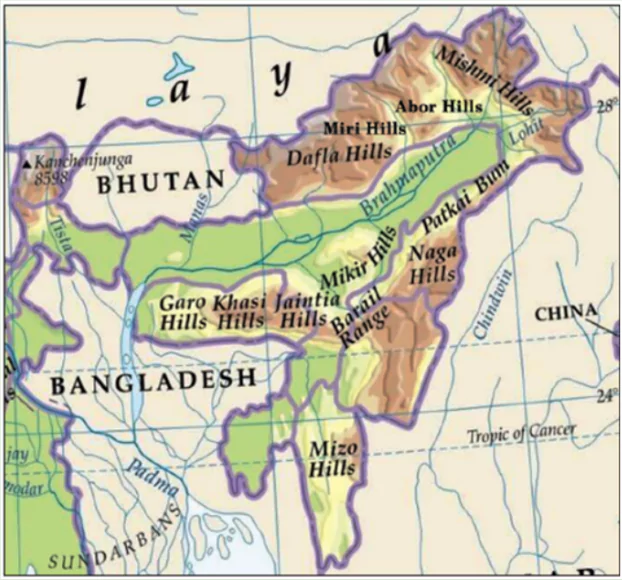A recent study has revealed that the eastern Himalayas in Arunachal Pradesh have lost 110 glaciers over a span of 32 years (1988-2020).
Key Findings of the Study
- The study, conducted by researchers from Nagaland University and Cotton University, used remote sensing and GIS technology to track glacier boundaries.
- The number of glaciers in Arunachal Pradesh decreased from 756 to 646 during the study period.
- The total glacial cover shrank from 585.23 sq. km to 309.85 sq. km, a loss of more than 47%.
- Most glaciers are located at an elevation of 4,500–4,800 metres, are north-facing, and lie on slopes of 15°–35°.
- This rapid glacial loss has exposed bedrock and created glacial lakes, raising the risk of glacial lake outburst floods (GLOFs).
Enroll now for UPSC Online Course
Eastern Himalayas
- The Eastern Himalayas extend between the Tista River in the west and the Brahmaputra River in the east, covering a stretch of about 720 km.
- This region is also known as the Assam Himalayas and primarily includes the areas of Arunachal Pradesh and Bhutan.

|
What is Glacial Retreat?
- Glacial retreat refers to the process where glaciers shrink as their ice melts faster than new snow accumulates.
- It is a key indicator of global climate change and is occurring at an alarming rate worldwide, especially in high-altitude regions like the Himalayas.
Causes of Glacial Retreat
- Climate Change: Rising global temperatures lead to increased ice melting, surpassing snow accumulation.
- Changes in Precipitation Patterns: Erratic snowfall and reduced winter precipitation slow down glacial growth.
- Black Carbon Deposition: Pollutants from human activities settle on glaciers, absorbing more heat and accelerating melting.
- Geological Factors: Slope, altitude, and rock type influence how glaciers respond to warming.
What are Glaciers?
- Glaciers are large, slow-moving masses of ice that form in regions where snowfall exceeds melting over long periods.
- They act as natural freshwater reservoirs and play a crucial role in regulating the Earth’s climate and water cycle.
Formation of Glaciers
- A glacier forms when snow accumulates over time, turns to ice, and begins to flow outwards and downwards under the pressure of its own weight.
- Accumulation: Snowfall collects in high-altitude or polar regions.
- Compaction: Over time, layers of snow compress under their own weight, forming dense ice.
- Glacial Movement: The glacier moves downslope due to gravity, carving the landscape as it advances.
- Ablation: Ice melts due to temperature changes, leading to glacial retreat.
|
Major Glaciers in India
The Himalayan region hosts the majority of India’s glaciers, serving as the source of major rivers like the Ganga and Yamuna.
- Siachen Glacier (Ladakh) – The longest glacier in India (76 km).
- Gangotri Glacier (Uttarakhand) – The source of the Ganges River.
- Yamunotri Glacier (Uttarakhand) – The origin of the Yamuna River.
- Zemu Glacier (Sikkim) – The largest glacier in the Eastern Himalayas.
- Rathong Glacier (Sikkim) – Supplies water to the Teesta River.
- Milam Glacier (Uttarakhand) – A major source of the Goriganga River.
- Pindari Glacier (Uttarakhand) – A popular trekking destination.
|
Himalayas under threat
- The Himalayas, often called the ‘Third Pole’, hold the largest collection of glaciers outside the polar regions.
- These glaciers are a crucial freshwater source for over 1.3 billion people in downstream regions.
- Climate studies show that the Himalayas have witnessed a temperature rise of 1.6°C over the past century.
- The eastern Himalayas, in particular, are warming at a rate higher than the global average, with temperatures increasing by 0.1° to 0.8°C per decade.
- By the end of the century, the region could see a 5-6°C temperature rise and 20-30% more precipitation.
Check Out UPSC Modules From PW Store
Impact of Glacial Retreat
- Freshwater Crisis: The retreating glaciers will severely affect water availability and distribution, impacting agriculture and drinking water supplies.
- Increased GLOF Risk: The formation of glacial lakes increases the chances of catastrophic floods, as seen in the 2023 Sikkim disaster that killed at least 55 people and destroyed a 1,200 MW hydropower project.
- Ecosystem Disruptions: Changes in temperature and precipitation patterns could destabilize ecosystems and impact biodiversity.
Glacial Lake Outburst Floods (GLOFs)
- Glacial Lake Outburst Floods (GLOFs) refer to the sudden release of water and sediment from glacial lakes that are naturally dammed by barriers such as moraines (debris of ice, sand, and pebbles) or glacier ice.
|
Ready to boost your UPSC 2025 preparation? Join PW’s UPSC online courses today!
![]() 4 Feb 2025
4 Feb 2025

